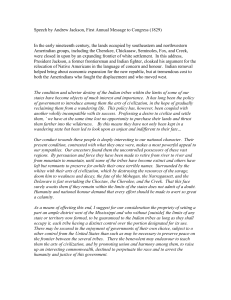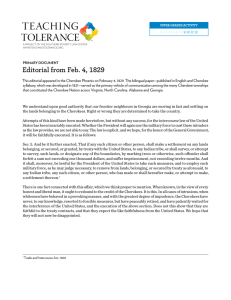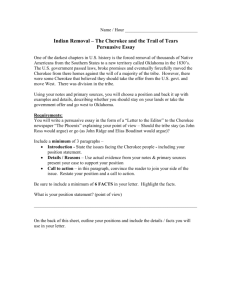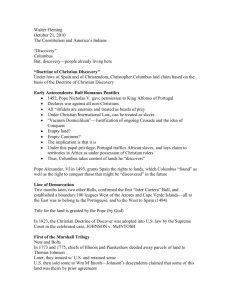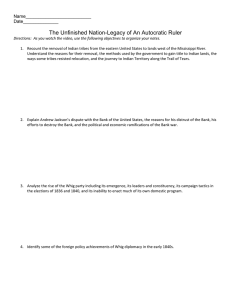Indian Removal & Trail of Tears Summary | Module
advertisement
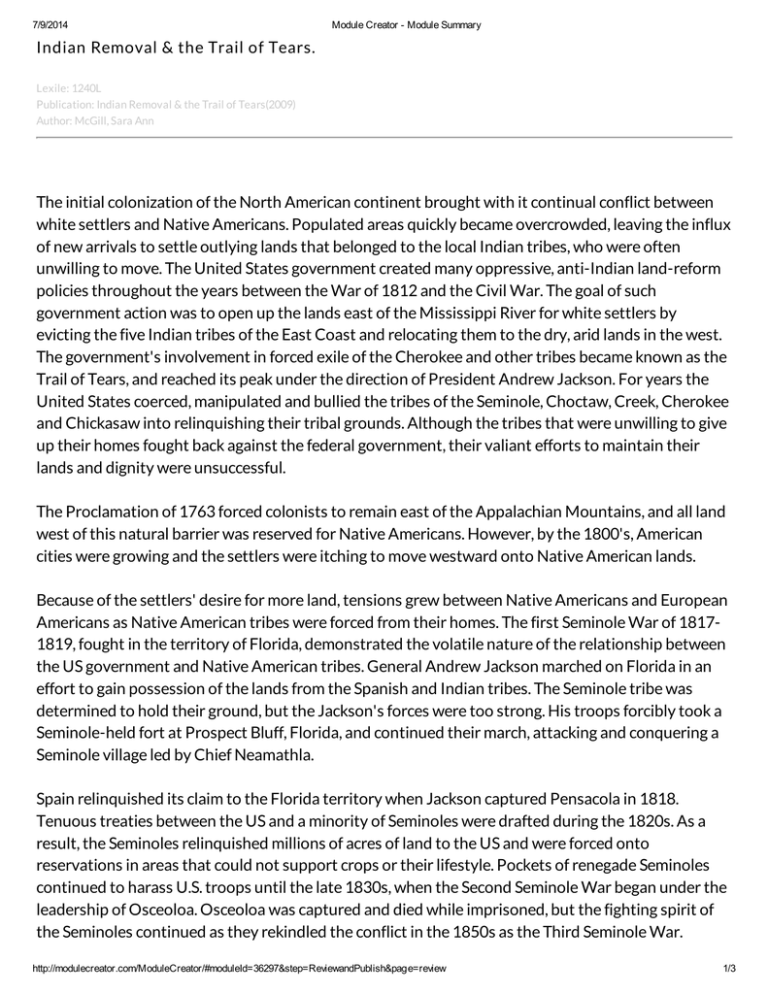
7/9/2014 Module Creator - Module Summary Indian Removal & the Trail of Tears. Lexile: 1240L Publication: Indian Removal & the Trail of Tears(2009) Author: McGill, Sara Ann The initial colonization of the North American continent brought with it continual conflict between white settlers and Native Americans. Populated areas quickly became overcrowded, leaving the influx of new arrivals to settle outlying lands that belonged to the local Indian tribes, who were often unwilling to move. The United States government created many oppressive, anti-Indian land-reform policies throughout the years between the War of 1812 and the Civil War. The goal of such government action was to open up the lands east of the Mississippi River for white settlers by evicting the five Indian tribes of the East Coast and relocating them to the dry, arid lands in the west. The government's involvement in forced exile of the Cherokee and other tribes became known as the Trail of Tears, and reached its peak under the direction of President Andrew Jackson. For years the United States coerced, manipulated and bullied the tribes of the Seminole, Choctaw, Creek, Cherokee and Chickasaw into relinquishing their tribal grounds. Although the tribes that were unwilling to give up their homes fought back against the federal government, their valiant efforts to maintain their lands and dignity were unsuccessful. The Proclamation of 1763 forced colonists to remain east of the Appalachian Mountains, and all land west of this natural barrier was reserved for Native Americans. However, by the 1800's, American cities were growing and the settlers were itching to move westward onto Native American lands. Because of the settlers' desire for more land, tensions grew between Native Americans and European Americans as Native American tribes were forced from their homes. The first Seminole War of 18171819, fought in the territory of Florida, demonstrated the volatile nature of the relationship between the US government and Native American tribes. General Andrew Jackson marched on Florida in an effort to gain possession of the lands from the Spanish and Indian tribes. The Seminole tribe was determined to hold their ground, but the Jackson's forces were too strong. His troops forcibly took a Seminole-held fort at Prospect Bluff, Florida, and continued their march, attacking and conquering a Seminole village led by Chief Neamathla. Spain relinquished its claim to the Florida territory when Jackson captured Pensacola in 1818. Tenuous treaties between the US and a minority of Seminoles were drafted during the 1820s. As a result, the Seminoles relinquished millions of acres of land to the US and were forced onto reservations in areas that could not support crops or their lifestyle. Pockets of renegade Seminoles continued to harass U.S. troops until the late 1830s, when the Second Seminole War began under the leadership of Osceoloa. Osceoloa was captured and died while imprisoned, but the fighting spirit of the Seminoles continued as they rekindled the conflict in the 1850s as the Third Seminole War. http://modulecreator.com/ModuleCreator/#moduleId=36297&step=ReviewandPublish&page=review 1/3 7/9/2014 Module Creator - Module Summary When Andrew Jackson became president in 1830, the Native American plight worsened. Congress allowed the president to solve the "Indian problem" with the Indian Removal Act of 1830. This act gave Jackson permission to offer tribes land west of the Mississippi River in exchange for their tribal lands east of the Mississippi. Politicians of the day considered this a generous offer, but the Native American population would not surrender their homes so easily. The federal government used unscrupulous tactics in order to get many tribes to accept the agreement. The US authorities designated Indian leaders to represent tribes in treaty negotiations in order to get them to agree to the government's terms. Often times, these leaders were not recognized by the tribes, so the treaties were not recognized by the majority of the tribal population. Chief Black Hawk, leader of the Fox and Sauk tribes, was one of the first victims of the federal government's "persuasive" tactics. He repeatedly refused to honor a treaty that gave the tribes' land to the US, but eventually agreed to move his tribe west, across the Mississippi River to the area of Iowa. Conditions were unfavorable, and, in desperation, Black Hawk led his people back to their original location. Upon their arrival, the tribe was confronted by troops, and what followed became known as Black Hawk's War. The federal government sent scores of troops against the small tribe, exterminating all men, women and children who could not keep ahead of the advancing army. In 1832, the tribes were defeated at Bad Axe Massacre on the Wisconsin River. Black Hawk was finally captured and forced to sign a treaty that would move the remaining Fox and Sauk tribes to an area west of the Mississippi River. There were others tribes that refused to leave their sacred grounds. The Creek Indians resisted for four years, until finally internal stress gave the government the opportunity to win them over. In 1836, the Creeks were escorted off their land and lead to the west. The Chickasaw tribe was the next to be forced from their home in 1837. The Trail of Tears was the result of the U.S. government's treatment of the Cherokee Nation. The Cherokee was the last tribe to fight for their home in the Appalachian region of North and South Carolina, as well as in Georgia, Tennessee and Alabama. The Cherokee developed a republican government ruled by a constitution in 1820, much like that of the U.S. Despite their organization, they could not stop the settlers' push for possession of Cherokee territory, especially when gold was discovered on their lands in Georgia. To keep the land in their own hands, the Cherokee passed a law that made any sale of Cherokee lands punishable by death. The state of Georgia then challenged the Cherokee assembly and declared their rule null and void in 1828. The majority part of the Cherokee government went to the Supreme Court in 1831 in an attempt to keep their autonomy. Chief Justice of the Supreme Court John Marshall decided in Cherokee Nation http://modulecreator.com/ModuleCreator/#moduleId=36297&step=ReviewandPublish&page=review 2/3 7/9/2014 Module Creator - Module Summary v. Georgia that the Cherokee were not citizens of the United States and therefore had no right to appeal to the Supreme Court. The issue was pursued a year later in 1832 in Worcester v. Georgia. Marshall, consistent with his former decision, said that Georgian laws had no power in Cherokee territory. Despite the Supreme Court victory that affirmed their autonomy, the Cherokee were forced to leave when President Jackson refused to enforce the Court's ruling. Jackson coerced a small faction to sign the Treaty of New Echota on December 29, 1835. The agreement gave the Cherokee territory to the government in exchange for new lands west of the Mississippi as well as approximately $5 million. The treaty was not supported by the majority of Cherokee and was in direct violation of the law that forbade the sale of Cherokee lands. Chief John Ross, of Cherokee and Scottish descent, led a number of Cherokee in protest against the treaty and Jackson's measures, but his efforts were to no avail. The federal government forced the Cherokee nation to leave all of their lands and livestock to find a new home in the less fertile lands of the arid west. The first group of 3,000 began their forced march in the summer 1838. The remaining 12,000 waited in prison camps and traveled through the freezing temperatures of the winter of 18381839. Four different routes were taken across Tennessee, Kentucky, Illinois and Missouri. Nealry one fourth of the Cherokee population died from starvation and disease. The rest had to endure the abuses of the military personnel, the extreme temperatures and the sorrow of leaving their homes. Once they arrived, the Cherokee joined the other displaced Native Americans in their new life on less fertile lands. Two acts passed in 1854 and 1866 reduced their territory to land only in Oklahoma, despite the former promises of the American government. The US government's oppressive treatment of Native Americans would continue for decades, reaching well into the twentieth century, as the government continually robbed them of their land, culture and dignity. By Sara Ann McGill http://modulecreator.com/ModuleCreator/#moduleId=36297&step=ReviewandPublish&page=review 3/3
